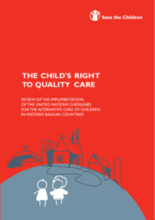In this paper, Save the Children International reviews the implementation of the UN Guidelines on the Alternative Care of Children in the Western Balkan Countries of Serbia, Montenegro, and Bosnia and Herzegovina. The report reviews the current situation and accomplishments in the process of reforming the child welfare systems in these countries. The paper offers a regional perspective and recommendations for decision makers, practitioners, and other interested parties for further development of the child welfare system in accordance with the UN guidelines on alternative care and in accordance with the rights of the child.
The report examines: the context of child welfare in the Western Balkans, the development of policies for alternative care of children, measures and programmes for the prevention of family separation, gatekeeping mechanisms, the availability of different forms of alternative care, the situation of children in alternative care, the process of leaving alternative care, the quality of formal alternative care, financing of alternative care, and other topics and mechanisms. The report concludes with recommendations from Save the Children on further development of child welfare.
In order to conduct this review, Save the Children utilized a desk analysis, reviewing relevant research, laws, policies, strategic documents, and more. Based on this review, Save the Children makes 14 recommendations to decision-makers and practitioners in the Western Balkan countries. Among these recommendations, Save the Children advises decision-makers to: create policies that promote family life and support parents, transform residential institutions, monitor and evaluate the implementation of new regulation mechanisms in Serbia and Montenegro and to create these mechanisms in Bosnia and Herzegovina, support gatekeeping mechanisms in Serbia and Montenegro and to develop these mechanisms in Bosnia and Herzegovina, employ appropriate personnel (including many more social workers), and to develop procedures to include the participation of children.

